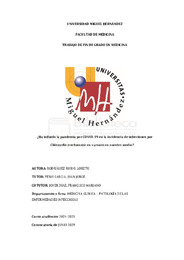Resumen :
Introducción y objetivo
Las infecciones de transmisión sexual suponen un problema de salud pública cuya incidencia está en aumento debido principalmente a las conductas sexuales de riesgo. Chlamydia trachomatis es una de las más prevalentes en España, afectando fundamentalmente a jóvenes, hombres que tienen sexo con hombres y adictos a drogas por vía parenteral. A finales de 2019 surge el COVID-19 y trajo consigo restricciones que pudieron afectar a la propagación de las infecciones de transmisión sexual.
Material y métodos
Se recogieron y analizaron las muestras de Chlamydia trachomatis realizadas en el Hospital Universitario de San Juan de Alicante entre 2017 y 2023, comparando la incidencia y las variables demográficas en los periodos prepandémico y postpandémico.
Resultados
En el periodo de estudio se analizaron un total de 20.422 muestras, de las cuales 1.509 fueron positivas, sin mostrar diferencias significativas en la incidencia entre los periodos prepandémico (7,5% ± 0,5 DE) y postpandémico (7,5% ± 0,5 DE). En lo que respecta a las variables, se observaron diferencias significativas entre ambos periodos en la nacionalidad española (80,9% en el periodo prepandémico y 58,3% en el postpandémico), en el origen de solicitud de la muestra (57,4% desde Atención Primaria en el periodo prepandémico y 74,8% desde el centro de información y prevención de SIDA en el postpandémico) y en los antecedentes de infecciones de transmisión sexual (10,6% en el periodo prepandémico y 49,5% en el postpandémico). En contraposición, las variables edad, infección por VIH y coinfección con otras infecciones de transmisión sexual no mostraron diferencias significativas. Conclusiones
La pandemia por SARS-CoV-2 no modificó la incidencia de Chlamydia trachomatis en nuestro medio. Sin embargo, se produjo un cambio epidemiológico postpandémico con un número de españoles infectados significativamente mayor, así como un mayor número de antecedentes de infecciones de transmisión sexual. También hubo cambios entre ambos periodos en el origen de solicitud de la muestra.
Background and objective Sexually transmitted infections represent a public health problem whose incidence is increasing, mainly due to risky sexual behaviors. Chlamydia trachomatis is one of the most prevalent in Spain, mainly affecting young people, men who have sex with men, and individuals who use intravenous drugs. At the end of 2019, COVID-19 emerged and brought restrictions that could influence the spread of sexually transmitted infections.
Methods Chlamydia trachomatis testing collected at the San Juan University Hospital in Alicante between 2017 and 2023 were analyzed, comparing incidence and demographic variables in the prepandemic and postpandemic periods.
Results During the study period, a total of 20,422 samples were analyzed, of which 1,509 were positive, with no significant differences in incidence between the prepandemic period (7.53% ± 0.53 SD) and the post-pandemic period (7.5% ± 0.55 SD). Regarding variables, significant differences were observed between both periods in Spanish nationality (80.9% in the prepandemic period and 58.3% in the postpandemic period), in the origin of the sample request (57.4% from Primary Care in the pre-pandemic period and 74.8% from the HIV information and prevention center in the postpandemic period), and in history of sexually transmitted infections (10.6% in the prepandemic period and 49.5% in the postpandemic period). In contrast, variables such as age, HIV infection, and coinfection with other sexually transmitted infections did not show significant differences.
Conclusions The SARS-CoV-2 pandemic did not alter the incidence of Chlamydia trachomatis in our setting. However, there was a postpandemic epidemiological change with a significantly higher number of infected Spanish men, as well as a greater number of patients with a history of sexually transmitted infections. There were also changes between both periods in the origin of the sample requests.
|
 La licencia se describe como: Atribución-NonComercial-NoDerivada 4.0 Internacional.
La licencia se describe como: Atribución-NonComercial-NoDerivada 4.0 Internacional.
.png)
